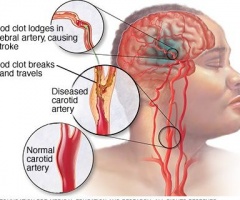What is Ischemic Stroke? Symptoms, Effects & Its Treatment

Ischemic Stroke is an acute, neurological event that is caused by an alteration in blood flow to the brain. The alteration in blood flow can be either a deprivation of blood to the brain tissue (ischemic stroke) or a spilling of blood (hemorrhagic stroke) onto the brain tissue. Ischemic strokes account for about 85% of all strokes. The symptoms after stroke vary depending on the size of the injury and which vessel has been affected.
Symptoms:
Both cognitive and physical symptoms can be present.
- Impairments in upper extremity are common after stroke. , the ability to open the fingers during a reach-to-grasp movement is altered because stroke impairs the ability to activate finger muscles and/or selectively activate them in the appropriate patterns.
- Weakness (Paresis) will present in one side of the body and can either be mild or severe which decides the level of the weakness.
- Another common impairment is aphasia, which means oral motor- and language impairments Aphasia may lead to limitations in speaking, understanding, reading and writing.
- Unilateral Neglect can be present after having a stroke, and appears as a lack of awareness to either right or left side of the body.
- Impairment in executive function can also be present after having a stroke. Executive function is referred to as complex cognitive function such as planning, problem solving and monitoring.
- Physical and cognitive impairments affect a patient’s independence in activities of daily living [ADL].
Role of Occupational Therapy:
The occupational therapy process for stroke patients begins with an investigation of a patient’s roles, tasks and activities that is important for the patient. Thereafter, the occupational therapist will investigate the ability to perform the roles, tasks and activities and if a disability in some area is found, the occupational therapist will try to find solutions or interventions that help the patient to restore, improve or maintain his or her functions.
The focus of occupational therapy is to help individuals achieve health, well-being, and participation in life through engagement in occupations (i.e., activities) (American Occupational Therapy Association [AOTA], 2014).
- Further retraining in self-care skills and adapting tasks or environments (post-rehab), including the appropriate use of adaptive equipment to maximize the ability to perform activities of daily living (ADLs) safely (e.g., bathing, dressing, functional mobility)
- Addressing ongoing deficits such as weakness, sensory loss, and cognitive or visual impairments that limit engagement in ADLs and instrumental ADLs (IADLS: carrying groceries, cooking a meal, managing money, parenting)
- Training in community reintegration and modifying tasks or environments, including, where appropriate, assessment of and training in the use of assistive technology, to maximize independent engagement in IADLs.
- Recommending adaptations to resume former leisure activities or develop new ones as feasible.
- Evaluating and treating swallowing difficulties
- Developing coping strategies to support psychosocial health and well-being (including relaxation techniques, if appropriate)
- Teaching and promoting healthy lifestyle habits and routines to minimize risk of secondary stroke
For more details contact
us on 📞9618906780
